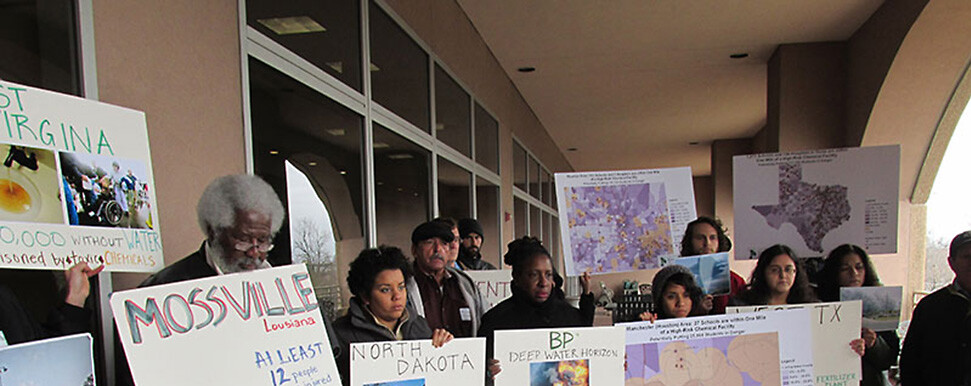
Media
August 19, 2022Updated RMP rule is an opportunity to prioritize Environmental Justice, take bold action on climate change, and stand with workers- if it includes key provisions
PRESS STATEMENT: August 19, 2022
Media Contact: Deidre Nelms, dnelms@comingcleaninc.org (802) 251-0203 ext. 711
Today, the U.S. Environmental Protection Agency proposed updated rules for hazardous chemical facilities to address the ongoing devastation of explosions, fires, health-harming chemical releases and other dangerous disasters that put thousands of communities and workers at risk every day. These facilities disproportionately impact people of color and low income communities.
In response to this proposed rule, EJHA issued the following statement:
The Risk Management Plan (RMP) rule is of the utmost importance to fenceline communities like those who make up the Environmental Justice Health Alliance for Chemical Policy Reform (EJHA) and we look forward to reviewing it alongside our strategic partner Coming Clean and other allies.
The EPA’s RMP rule is meant to be a critical safeguard to prevent chemical disasters like 1984 gas release from the Union Carbide/Dow facility in Bhopal, India and persistent contamination that continues to affect more than a half million people. To date, the RMP has never fully lived up to that mandate–as evidenced by the approximately 150 harmful incidents that occur on average at industrial facilities every year, over the most recent decade for which EPA has public data. It is due more to good fortune than good planning that the U.S. has avoided a Bhopal-scale disaster.
Ensuring that this RMP Rule is strong enough to protect workers and communities has been a top priority for EJHA for years. Consistent with our many past comments on this program (spanning at least the last three presidential administrations), we continue to call for the following provisions in an updated rule:
- EPA should require, rather than merely advise, facilities to reduce or remove dangerous chemicals and processes when safer technology or chemicals are available. Hazard reduction measures, such as the use of inherently safer technology, chemicals and processes, have been recommended multiple times by the U.S. Chemical Safety and Hazard Investigation Board (CSB) as well as by EJ, labor, environmental and health advocates.
- EPA should explicitly require facilities to assess and implement preparations for climate hazards like hurricanes, storm surges, flooding and wildfires that increase the risk of chemical disasters, as recommended by the U.S. Government Accountability Office.
- EPA should include common-sense emergency response and incident management requirements in an updated rule, such as realtime fenceline air monitoring, enough back-up power to safely run and/or shutdown the facility in the event the power goes out, multilingual alerts, and advance community notification about the plan for emergencies — before an incident occurs.
- EPA should increase enforceability, corrective action, and accountability in the rule, in part by recognizing workers as key partners in chemical disaster prevention, through measures like stop-work authority and anonymous safety reporting.
- EPA should expand coverage of the rules and the program to more chemicals and facilities, including ammonium nitrate, to prevent incidents like the devastating West, Texas disaster, and the recent chemical fire at the Weaver fertilizer plant that could have triggered a major explosion.
- EPA should account for cumulative health impacts from multiple polluting facilities by requiring more layers of prevention at facilities contributing to cumulative health stressors.
President Biden has promised to prioritize Environmental Justice and protect EJ communities, take bold action on climate change, and stand with workers. In this rule his administration has the opportunity to do all three at once. We are counting on this Administration to deliver on their promises to EJ communities and workers by using EPA’s full authority to deliver a final RMP rule that lives up to what the moment and our communities demand, to truly prevent chemical disasters.
“We are glad to see that EPA is following through on their commitment to reconsider the RMP rule and look forward to reviewing it closely and weighing in to ensure the final rule meets the moment,” said Michele Roberts, National Co-Coordinator of the Environmental Justice Health Alliance for Chemical Policy Reform. “Preventing chemical disasters is a top priority for EJHA affiliates and we are counting on this administration to deliver a truly protective rule that does so. In this single rule, President Biden & Administrator Regan can live up to their commitments to protect fenceline communities, stand with workers and act on climate change. We are counting on EPA to have the moral and political courage to keep the promises President Biden has made to our communities.”
###
The Environmental Justice Health Alliance for Chemical Policy Reform is a national network of grassroots Environmental and Economic Justice organizations and advocates in communities that are disproportionately impacted by toxic chemicals from legacy contamination, ongoing exposure to polluting facilities and health-harming chemicals in household products. EJHA supports a just transition towards safer chemicals and a pollution-free economy that leaves no community or worker behind.
